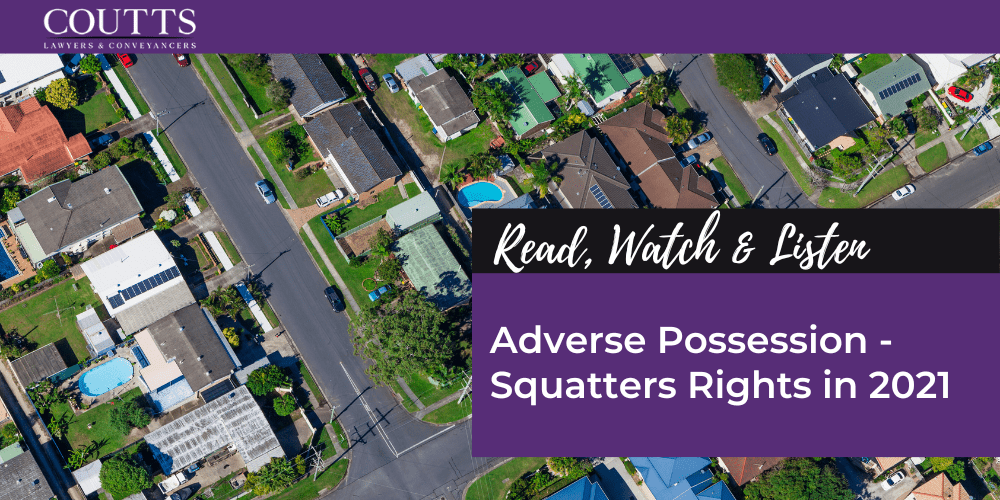KEY TAKE OUTS
- Adverse Possession, or ‘Squatter’s Rights’, is still a controversial topic in 2021.
- In Hardy v Sidoti (2020), the ownership of a small parcel of land known as ‘dunny lane’ became the subject of debate between neighbours.
- It was found that adverse possession was satisfied through a set of criteria, with emphasis on a ‘definitive and public act of possession’ in removing a paling fence.
What is adverse possession?
Also known as ‘Squatter’s Rights’, adverse possession is the process of legally asserting physical ownership of land after a period of time.
Limitation Period: How Long Does Possession Need to Occur?
In NSW, an adverse possessor must have exclusive occupation of the land for 12 years before claiming adverse possession. In very extreme circumstances, there may be reasons for the limitation period to be extended.
What criteria must be met to establish adverse possession? (Mulcahy v Curamore Pty Ltd [1974])
There are three main elements from the above case which guide successful adverse possession.
- The possession must be ’open, not secret.’ This means the possession is able to be noticed by the documentary owner who is reasonably careful of their own interests.
- The possession must be ‘peaceful, not by force.’ Force may be used to begin adverse possession, however, but not to maintain it.
- It must be adverse so that it is not by consent of the owner. If permission is given but later revoked, ‘adverse’ begins from the date of revocation. Similarly, if there is an absence of consent initially, but is given at a later stage, any time accrued towards the limitation period for adverse possession is void at the date of consent. Family relationships exclude the possibility of permission.
How is adverse possession proven?
The possessor must prove that they had actual or intended possession. This involves an intention to exclude land to all others, but only by possession and not ownership.
Evidence
Consideration is given to the ‘character and value of the property, suitable and natural mode of using it’ and conduct of the owner in protecting his own interests. For example, the construction of a fence is usually the ‘strongest possible evidence’ of adverse possession. Evidence that the possessor ‘could have done more’ to the land is not considered. Mistaken belief of ownership or willingness to pay if requested is also irrelevant as evidence of possession.
Payment of rates and taxes
The paying of rates and taxes is important as a contributing factor of proof, but not conclusive. However, a refusal to pay rates becomes contrary to the intention to possess.
Can the owner retake possession?
In reclaiming possession, it is important to note that the time period of repossession is irrelevant. For example, 45 minutes of repossession can nullify 19 years of adverse possession.
The documentary owner can reclaim possession in two ways:
-
By physical entry
Rights to the land must be reasserted before limitation period. This includes acts such as removing the possessor, or lesser acts such as removing fences or other structures. The owner must resume possession ‘with the intention of repossessing’, however must not undertake this by way of violence or force. Oral or written protests, and paper dealings such as a mortgage or lease, do not qualify as repossession.
-
By court proceedings
The time of adverse possession stops when court proceedings are commenced, so it is commonly advised to ‘litigate first, negotiate later.’ This is commenced by the issue and service of a summons for possession with the intention of obtaining an order for possession. Once proceedings commence within the limitation period, the adverse possessor’s rights are terminated. If this summons is dismissed, time starts over again from this date.
Hardy v Sidoti (2020)
Facts
In Hardy v Sidoti, Mr Hardy bought his property in Redfern in 1998 which backed onto a ‘dunny lane’, a small area developed to collect waste from outdoor dunnies in the 19th Century. In 2002, he removed a paling fence separating the lane from his backyard and made improvements to the land over 3 years. Sidoti then purchased a property in 2018 that backed onto the opposing side of dunny lane. Despite a corrugated iron fence separating the land, the lane was included as part of their property. Sidoti attempted to undertake renovations to the area to extend their backyard when Hardy claimed adverse possession.
Decision
Kunc J found that Hardy had been in possession prior to the limited folio created over the Sidoti property in 2005, evident by removing the paling fence in 2002. This in conjunction with the landscaping over the 3 year period demonstrated a public display of ownership such that any reasonable person could recognise him as the owner. Kunc J concluded that ‘He is entitled to orders to recognise that ownership, including that the defendants cease to trespass… and by removing structures they have erected on it and relocating the fence they have built.’
While adverse possession laws continue to be in contention, there is not likely to be any reform in the coming years.
For further information please don’t hesitate to contact Coutts Lawyers.
This blog is merely general and non-specific information on the subject matter and is not and should not be considered or relied on as legal advice. Coutts is not responsible for any cost, expense, loss or liability whatsoever to this blog, including all or any reliance on this blog or use or application of this blog by you.



